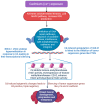Epigenetic Mechanisms of Endocrine-Disrupting Chemicals in Breast Cancer and Their Impact on Dietary Intake
- PMID: 39846533
- PMCID: PMC11755457
- DOI: 10.3390/jox15010001
Epigenetic Mechanisms of Endocrine-Disrupting Chemicals in Breast Cancer and Their Impact on Dietary Intake
Abstract
Addressing the consequences of exposure to endocrine-disrupting chemicals (EDCs) demands thorough research and elucidation of the mechanism by which EDCs negatively impact women and lead to breast cancer (BC). Endocrine disruptors can affect major pathways through various means, including histone modifications, the erroneous expression of microRNA (miRNA), DNA methylation, and epigenetic modifications. However, it is still uncertain if the epigenetic modifications triggered by EDCs can help predict negative outcomes. Consequently, it is important to understand how different endocrine disrupters or signals interact with epigenetic modifications and regulate signalling mechanisms. This study proposes that the epigenome may be negatively impacted by several EDCs, such as cadmium, arsenic, lead, bisphenol A, phthalates, polychlorinated biphenyls and parabens, organochlorine, and dioxins. Further, this study also examines the impact of EDCs on lifestyle variables. In breast cancer research, it is essential to consider the potential impacts of EDC exposure and comprehend how EDCs function in tissues.
Keywords: breast cancer; dietary exposure; endocrine disruptors; epigenetic.
Conflict of interest statement
The authors declare that no conflicts of interest.
Figures











Similar articles
-
Impact of endocrine disrupting chemicals (EDCs) on epigenetic regulation in the uterus: a narrative review.Reprod Biol Endocrinol. 2025 May 26;23(1):80. doi: 10.1186/s12958-025-01413-z. Reprod Biol Endocrinol. 2025. PMID: 40420228 Free PMC article. Review.
-
Endocrine disrupting chemicals and breast cancer: a systematic review of epidemiological studies.Crit Rev Food Sci Nutr. 2022;62(24):6549-6576. doi: 10.1080/10408398.2021.1903382. Epub 2021 Apr 5. Crit Rev Food Sci Nutr. 2022. PMID: 33819127
-
Endocrine disruptors and endometriosis.Reprod Toxicol. 2023 Jan;115:56-73. doi: 10.1016/j.reprotox.2022.11.007. Epub 2022 Nov 24. Reprod Toxicol. 2023. PMID: 36436816 Review.
-
An epigenome-wide association study identifies multiple DNA methylation markers of exposure to endocrine disruptors.Environ Int. 2020 Nov;144:106016. doi: 10.1016/j.envint.2020.106016. Epub 2020 Sep 9. Environ Int. 2020. PMID: 32916427
-
Endocrine disrupting chemicals impact on ovarian aging: Evidence from epidemiological and experimental evidence.Environ Pollut. 2022 Jul 15;305:119269. doi: 10.1016/j.envpol.2022.119269. Epub 2022 Apr 8. Environ Pollut. 2022. PMID: 35405219 Review.
Cited by
-
Unraveling the Core of Endometriosis: The Impact of Endocrine Disruptors.Int J Mol Sci. 2025 Aug 6;26(15):7600. doi: 10.3390/ijms26157600. Int J Mol Sci. 2025. PMID: 40806727 Free PMC article. Review.
-
Epigenetic Consequences of In Utero PFAS Exposure: Implications for Development and Long-Term Health.Int J Environ Res Public Health. 2025 Jun 10;22(6):917. doi: 10.3390/ijerph22060917. Int J Environ Res Public Health. 2025. PMID: 40566344 Free PMC article. Review.
-
Molecular mechanisms of polychlorinated biphenyls in breast cancer: insights from network toxicology and molecular docking approaches.Front Pharmacol. 2025 Jun 13;16:1604993. doi: 10.3389/fphar.2025.1604993. eCollection 2025. Front Pharmacol. 2025. PMID: 40584614 Free PMC article.
References
-
- [(accessed on 23 November 2024)]. Available online: https://www.who.int/news-room/fact-sheets/detail/breast-cancer.
Publication types
Grants and funding
LinkOut - more resources
Full Text Sources

